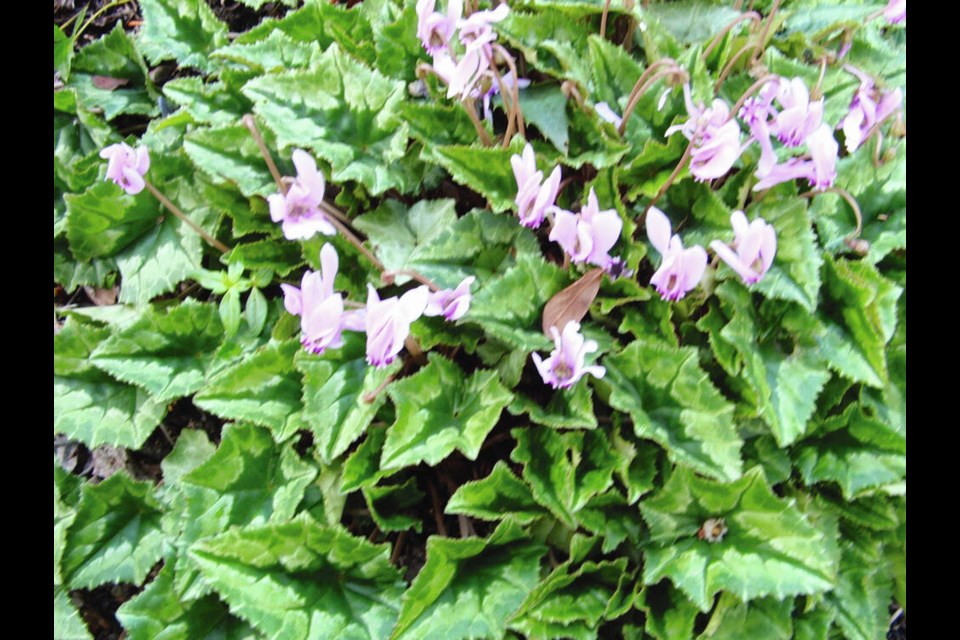Dear Helen: I took note of a recent Times Colonist article on the toxic, invasive Arum italicum and wonder whether a patch of low-growing leaves in my winter garden might be this plant. My leaves are in two tones of green, the darker in the centre part. The shape is variable. Some are rather rounded, others pointed. I’ve attached a photo.
R.S.
Your leaves look like the hardy ivy-leaved cyclamen. My plantings display similar carpets of leaves all winter until they disappear in the warmth of May. The leaves emerge in the fall, after the late summer and early autumn bloom season is finished.
Arum italicum has arrow-shaped leaves with white veins. The leaves appear in autumn and remain through the winter. Flowering time is in April and May.
Dear Helen: My brother is trying to figure out whether the hedges in his new home are bay laurel or cherry laurel. His two dogs have a habit of eating plants and we have heard that cherry laurel is poisonous. That’s why he really needs to know.
C.B.
Cherry laurel has been a popular hedging plant. It grows fast, but that speedy growth also means it requires considerable maintenance to keep the hedges tidy.
Most parts of a cherry laurel hedge — leaves, seeds, stems — are considered highly toxic. That includes for cats and dogs.
If the plants are clearly arranged as hedging, your brother can presume they are cherry laurel (Prunus laurocerasus). To check, suggest that he pick and massage a few leaves. If by rare chance the plants are bay laurel (sweet bay, Laurus nobilis), the foliage will release the familiar, sweet bay leaf fragrance.
Sweet bay leaves are also not so bright and shiny as cherry laurel foliage.
Dear Helen: The vegetable garden on my large property has expanded enough over the years to become a sort of mini-farm, productive enough for me to sell some of the vegetables. Are you familiar with any seed companies that distribute to both farmers and home gardeners? Are there any that you would recommend?
G.F.
All seed companies offer a variety of packet sizes to accommodate both home gardeners and commercial growers. Stokes Seeds has long been a source for many growers.
I can pass along what grower/vendors at my own farmers’ market tell me about their preferred sources. Johnny’s Selected Seeds in Maine is popular. I recognize some of their Salanova lettuces for sale at several of the stalls during the growing season. The catalogue is well geared to both home garden and commercial grower needs.
Some of my best vegetable varieties come from Johnny’s, which has a well-established breeding program that has produced many award-winning varieties.
I learned of another source from an enthusiastic young farmer at my local Saturday morning market, where he has fast become one of the more popular vendors. He uses Osborne Seeds in Washington state.
This company has a Canadian representative and an office in the Lower Mainland, and distributes to home gardeners though that’s not the company’s main, target market. Not all seeds are available in the small quantities suited to most home gardeners, though many, like tomatoes and peppers, are available in packets of just 25 seeds.
The Osborne vegetable and flower listings are worth looking at. Radicchio fans will be enthralled with the company’s two pages of colourful varieties.
Dear Helen: After I use moss killer on the lawn and then de-thatch to clear away the dead moss, can I put the removed moss in a compost heap?
F.W.
That depends on what kind of moss killer is used. Most commercial products are based on ferrous (iron) sulphate. Moss killed with an iron sulphate product can be raked up and added, sparingly, to compost heaps.
Add the moss, which by nature decays slowly, at the rate of one part to four parts in volume of other composting materials. If there is a large quantity of moss, store it for adding in small amounts along with other materials as they become available.
A moss removal project is best undertaken as the weather warms in spring and the moss is growing most actively. Avoid applying moss killer in hot weather, and do not use it on new lawns. Wait until a lawn is established enough to have been mowed at least four times.



